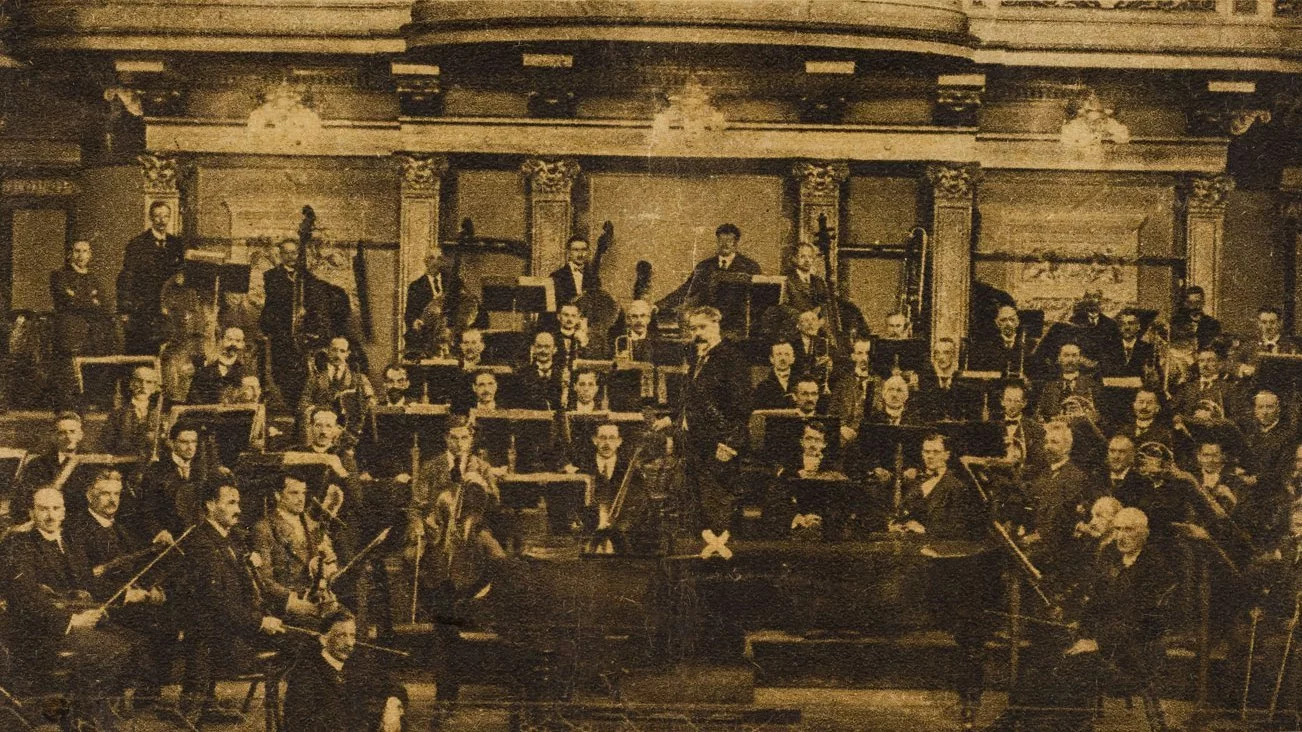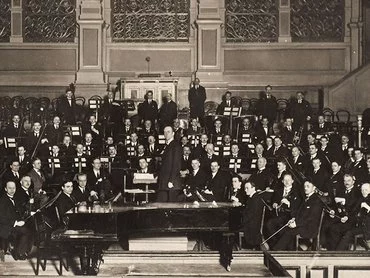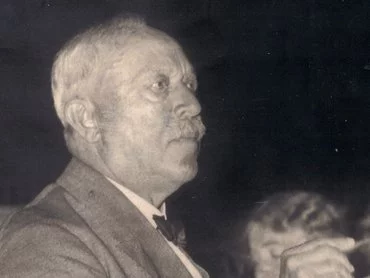- History
- Orchestra History

When the First World War broke out in 1914, it had a devastating effect on Germany’s musical scene. Notable orchestras in cities such as Munich, Cologne, Dresden, Bonn and Königsberg were forced to cease performing or to reduce their concerts dramatically. The Berliner Philharmoniker, however, was not affected by the social and military turmoil. Not only did the orchestra sustain its operations, it also increased the number of concerts it gave and provided political, diplomatic, financial, social and philanthropic contributions to the German war efforts.
Between August 1914 and November 1918, the Berliner Philharmoniker gave a total of 631 concerts, mostly in Berlin. The prestigious Subscription, Symphony and Soloist Concerts took place in the Philharmonie on Bernburger Straße, while the leisurely People’s Concerts were held all over the capital, in the Volksbühne Theater at Bülowplatz, the Neue Philharmonie on Köpenicker Straße, the Stadttheater in Moabit and the Germania Prachtsäle on Chausseestraße.
102 Charity concerts
At least 102 of these concerts were designated a specific charitable purpose, and approximately 2.5 million marks were raised in support of unemployed musicians and artists, families of wounded soldiers, widows and orphans of fallen soldiers, war children’s welfare, field hospitals, war relief funds, Germans that were forced to leave Belgium, humanitarian organisations in Austria and Bulgaria, as well as the Regiments, the Army Corps, the Navy and the Eastern Army. To maximise the amount donated, the players of the Berliner Philharmoniker agreed to a reduction in salary of 40 marks a month, while resident conductor Camillo Hildebrandt received only 6,000 marks (instead of 9,000 marks) per season.
In addition to an intensive performance schedule in its home city, the Berliner Philharmoniker also frequently toured other parts of the German Empire, from Hamburg to Dresden, Frankfurt am Main, Mannheim, Hannover, Cologne, Jena, Magdeburg, Stettin, Breslau, Görlitz and Katowice. Furthermore, on three separate occasions, the orchestra travelled abroad to deliver a form of soft power within the Reich’s foreign policy. Its 1915 visit to occupied Brussels was an attempt to extend the German occupation into the spiritual realm and to assist in the moral conquest of Belgium.
Two years later, the Berliner Philharmoniker’s appearances in Copenhagen, Stockholm, Gothenburg and Malmö were part of a wider effort to solicit support from the Scandinavian countries and to demonstrate that Germany was willing to engage in dialogue through the use of high culture. And in 1918, at the nadir of the First World War for the Central Powers, the Berlin Philharmonic travelled to the Musikverein in Vienna on a propaganda mission, seeking to accentuate the partnership, mutual appreciation and cultural superiority of the German and Austro-Hungarian Empires. Apart from those given on the Belgian tour, the concerts were all conducted by Arthur Nikisch, the orchestra’s indomitable chief conductor, who once noted that his mission was to ‘build bridges through the arts to achieve mutual understanding and reconciliation between peoples’.
Austro-German repertoire
Throughout the First World War, the Berliner Philharmoniker focused its repertoire on the Austro-German canon, with French, Italian and Russian music (Tchaikovsky excepted) performed on only the rarest of occasions. Concerts were frequently dominated by the works of J. S. Bach, Haydn, Mozart, Beethoven, Schubert, Mendelssohn, Weber, Schumann, Liszt, Brahms, Wagner and Richard Strauss. The orchestra’s nationalistic and patriotic outlook between 1914 and 1918 meant that the music of these composers was performed over and over again. The following works were particularly popular and could be heard numerous times every season: all of Beethoven’s symphonies, concertos and overtures; excerpts from Wagner’s Die Meistersinger von Nürnberg, Tannhäuser, Lohengrin and Die Walküre; Brahms’s First and Fourth Symphonies, the Violin Concerto and Ein deutsches Requiem; excerpts from Weber’s Der Freischütz and Euryanthe; Schubert’s Unfinished symphony; Mendelssohn’s Violin Concerto; Richard Strauss’ Don Juan; Liszt’s Les préludes and First Piano Concerto; and excerpts from Mozart’s Le nozze di Figaro and Die Zauberflöte.
Due to travel restrictions imposed by the warring nations, foreign conductors and soloists found it increasingly difficult to visit the German Empire. As a result, Arthur Nikisch and Camillo Hildebrandt were repeatedly engaged and conducted a total of 330 concerts between them. Similarly, the orchestra’s five concertmasters – namely Julius Thornberg, Licco Amar, Géza von Kresz, Louis Persinger and Franz Veit – took on a large number of solo responsibilities and gave 135 concerto performances. Musicians hailing from outside the German and Austro-Hungarian Empires largely disappeared from Berlin’s music scene and returned only after the Armistice was signed.
Although conscription adversely affected numerous German orchestras at the time, the Berliner Philharmoniker avoided the full brunt of this problem. Most of its eligible musicians, especially the concertmasters and solo players, were not drafted at all, while the rest had to serve on the fronts, on average, for only half as long as other soldiers. Unfortunately, though, two members of the Berliner Philharmoniker did lose their lives – cellist Alfred Michaelis died in British captivity, having lost an arm, and bassoonist Fritz Schweinitz was reported missing in action; violinists Willy Bufé and Alwin Kappelsberger, meanwhile, sustained injuries that forced them to retire from the orchestra.
Sold out concerts
In spite of these four cases of individual tragedy, the Berliner Philharmoniker stood firm, remained resolutely on duty in the concert hall, and performed in front of around 1.8 million Germans during the First World War, with only four of its concerts failing to sell out. The orchestra provided audiences with an opportunity to rejoice heartily in the magnificent quality of German music and to attain a sense of belonging to a national community. In particular, its patriotic and celebratory concerts stirred up nationalistic feelings, galvanised civilian morale and constructed a unified German home front, while its commemorative and memorial events allowed Germans to experience consolation, mourning and transfiguration, and created an emotional environment that ensured no one would suffer alone.
When the First World War ended, Germany had to endure the effects of a brutal total war that lasted significantly longer than anticipated. The revolution of 1918/1919, the Spartacist Uprising, the economic recession and the Spanish Flu epidemic left the country in tatters; Germany’s federal constitutional monarchy was also replaced by a democratic parliamentary republic. Amidst all these problems, though, the Berliner Philharmoniker still continued its hectic concert schedule, giving well over 120 concerts per season, touring extensively across the country and contributing to a wide array of charitable causes. The orchestra’s tenacity, resilience and endeavour to support Germany through dark and difficult times helped to cement its status in the country’s social, cultural and political life in the years ahead.

